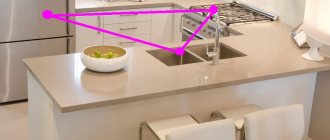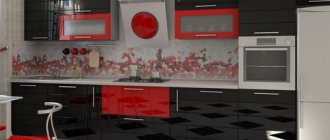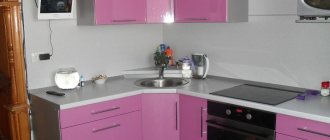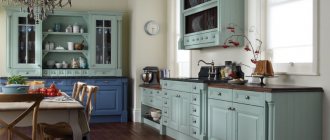Food storage area
The refrigerator is quite a tall object, because of this it is not possible to place it outside the kitchen corners, since it will tear the kitchen space into small areas, which in itself is ugly and inconvenient.
When installing it, you should take into account the direction in which the door opens; it should not block free space and interfere with movement. Today, refrigerator manufacturers have taken this nuance into account and offer customers models with removable doors; if necessary, they can be moved to the other side. Related links: Why Japanese curtains have become so popular in apartment interiors
Designer recommendations
When two housewives are cooking in the kitchen, you should be very careful when planning the work triangle. Their trajectory of movement will intersect if the scheme is thought out incorrectly. This will not only be uncomfortable, but also dangerous, given that in the kitchen you have to deal with boiling water and hot oil.
An isosceles triangle is considered ideal, but it is difficult to implement such an idea in a small kitchen. Here it would be more appropriate to arrange the furniture in one line.
An island kitchen requires as much free space as possible. For comfortable use of space around the island there must be a place with a radius of at least 1.2 meters.
It is more convenient to place the cooking and washing areas nearby so that there is no need to cross the aisle with dangerous hot pots and a kettle. When the island is large, it is worth installing a sink with a stove. It can also be used to store kitchen utensils or to organize seating.
What kind of kitchen do you have?
What should be the distance of the triangle
There are sides of the working triangle. From the refrigerator to the sink, from the sink to the stove, from the stove to the refrigerator. Distance plays an important role in convenience and time. The distance between elements in the kitchen should not be less than 1.2 meters and more than 2.7 meters. All sides together should not exceed 4-8 meters. The kitchen should not be a walk-through room, and if you can’t do otherwise, then try to ensure that all paths in the kitchen are safe.
The passage width must be at least 110 cm. The sink must be at least 45 cm, with a clean surface. Of course, there are small sinks, but they are not convenient for washing dishes, because to wash dishes or fruits, you need a lot of space. The towel should hang next to the sink. The refrigerator should open without obstacles. The above points must always be observed, no matter how your furniture is located. There should be free space between the refrigerator and the sink.
Basic principles of ergonomics in the kitchen when planning
The term “ergonomics” itself came to us from the Greek language; literally translated, it consists of two derivatives “ergon” - work, and “nomos” - law. The term denotes a whole section of scientific research related to the study of the work of the human body and the relationship between labor productivity and energy expenditure.
Correct ergonomics in the kitchen is ensured through proper design and arrangement of furniture in such a way that the housewife spends a minimum of effort when working. Studies have shown that following the basic principles of ergonomics in the kitchen will save up to 30% of your time and make your work easier by 50%. Mainly due to compliance with the basic rule of the “working triangle” and compliance with the standards of kitchen furniture with proper placement of household appliances.
Neufert and ergonomics in the kitchen, the triangle rule
The term “work triangle”, familiar to many, was introduced by the German architect Neufert. He proposed optimizing movement between three main centers of activity: the sink, the refrigerator and the stove. Ideally, all three centers should be located at the vertices of an equilateral triangle, then the cost of moving the housewife will be minimal.
But in reality everything turned out to be somewhat more complicated. The layout of small kitchens and large ones, with a regular and elongated shape, may differ. However, the general principles of ergonomics in the kitchen remain the same in all cases:
- The sink is the main center of activity. According to research, the owner spends approximately 50% of all time near her. Therefore, its position, the location of adjacent modules with drawers and wall cabinets with drying should be as convenient as possible.
- The slab is the second most important center of activity. It is advisable to place it at a distance of 800-1200 mm from the sink, in large kitchens - up to 1800 mm. Optimally – as close to the dining area as possible.
- It is better to place the refrigerator, freezer, and other modules used for storing food in the corner of the kitchen so as not to “tear” the work surfaces into non-functional areas. With proper ergonomics in the kitchen, the refrigerator should be no further than 1200mm from the stove and 1800mm from the sink. But with different kitchen layouts, this distance can either decrease or increase.
General ergonomics of the kitchen space depending on the layout of the unit
Here are the TOP 5 useful tips on how to maintain proper ergonomics in the kitchen:
When designing a kitchen set, consider your own physical parameters. So, the height of the working surface is determined by the arms bent at right angles at the elbows: there should be about 150mm between them and the working surface. And you will forget about back pain when cooking for a long time. Also, the maximum shelf level in wall cabinets should be at the distance of your outstretched arm minus 250mm. Make sure there is sufficient lighting on the work surface. Use spotlights for this above the main areas - sink, stove, food processing area. Also plan sockets for connecting household appliances; they should not “go” into the sink and stove areas, this is dangerous. Experience shows that the main injury and fire hazards arise near the stove. It should not be located in the aisle, near a pencil case, refrigerator or window with a curtain. The distance from the hob to the hood must be at least 700mm for an electric stove and 800mm for a gas stove. With proper ergonomics in the kitchen, the washing machine and dishwasher are located as close as possible to the sink and communications with drainage and water supply. Take care about the placement of sockets for them - they should not be located exactly behind the appliances
In this case, in the event of a breakdown or emergency, you will have to pull them out first to turn them off, and this is not the best option. The quality of fittings, pull-out and lifting mechanisms is also important so that the ergonomics in the kitchen correspond to a high level of comfort. Doors should open without noise or creaking, just like roll-out and pull-out storage systems. The ease of operation and service life of kitchen furniture as a whole depends on this.
If possible, install door closers on your kitchen cabinets; there are plenty of budget options.
The ease of operation and service life of kitchen furniture as a whole depends on this. If possible, install door closers on your kitchen cabinets; there are plenty of budget options.
Kitchen layout - the concept of a working triangle
Proper arrangement of the refrigerator, sink and stove will help save energy and time in the kitchen.
If you are planning a kitchen remodel and are looking for supporting information material, you have probably already heard or read about the kitchen work triangle. Designers consider this principle to be the best way to organize a kitchen space, but the concept itself may seem a little complicated to those who are not familiar with it.
In fact, the idea is very simple to implement, and, moreover, it will help save time and effort when preparing food. The kitchen work area, the kitchen triangle, combines the three main elements of the kitchen - the stove, the sink and the refrigerator. And while understanding the concept is important, it's always okay to deviate from the basic rules to ensure your design meets your needs.
Kitchen layout - the concept of a working triangle
What is a kitchen triangle?
The idea of the kitchen work triangle was developed in the 1940s, at a time when kitchens were very small and equipment was bulky. The kitchen was then perceived only as a place for preparing food.
The work triangle includes three main kitchen work areas:
- cooking area - stove,
- washing area - sink,
- storage area - refrigerator.
It is accepted as a standard that the distance between them does not exceed 2.7 meters and is at least 1.2 meters. The total sum of these distances should be between 4 and 8 meters. If the distance is too small, the kitchen will seem cramped, but if it is too large, the cooking process will be tedious.
Why is this worth thinking about?
Although this rule is over 70 years old, it is still relevant in kitchen design. Keeping distances between key work areas helps streamline the food preparation process and minimizes physical activity.
How to apply this concept in your kitchen?
Think about how comfortable it is for you to move around the kitchen.
What don't you like about your kitchen? What causes you inconvenience? What needs to be removed or added first in order to get by with low financial costs? A clear understanding of what causes you discomfort will help you properly organize your kitchen work areas according to the triangle rule.
During the era of the development of the triangle concept, the size of kitchens did not allow freedom to use decorations and individualize the interior. Now they are much more spacious. The kitchen has become the center of the home and often shares space with the dining room or living room.
If you are going to change the layout of the kitchen, you will want to organize an area here for receiving guests, family feasts and simply having a pleasant time. By concentrating the main work areas in one place, you can use the rest of the space as you wish.
Kitchen layout - ease of movement
If you already have a kitchen triangle organized, evaluate how rationally it is designed and what can be changed in it to improve it.
Remember that the distances in the triangle do not have to be absolutely equal. They will depend on the shape of the room.
In addition to observing the recommended distances between the elements of the triangle, it is important to organize it so that there is no interference on the passage. Garbage bins, pieces of furniture or kitchen utensils placed in the wrong place can make cooking difficult.
Kitchen Layout - Assessing the Work Triangle
Consider additional features in advance.
Modern kitchens have become multi-purpose rooms, so it is important to carefully consider in advance what additional functions the kitchen will perform. Having a clear idea of what else you want in your kitchen—a homework area, a bar, a large dining table, or additional sinks—will help you organize your kitchen triangle more efficiently.
Auxiliary areas are often neglected because they do not appear directly in the equation of the kitchen triangle. It is helpful to have one utility area near the stove and one near the sink. Place pots, dishes and spices closer to the stove so you don't have to go to the other end of the kitchen to get them.
Zoning the kitchen taking into account the work triangle
There is no need to strictly follow the rules - let the design and arrangement harmonize with the layout of your kitchen.
First of all, your kitchen should be convenient for you. Although the triangle rule is very useful, it is not a dogma. You may have to organize your entire work area along one wall. In this case, it will be impossible to comply with the triangle rule. Take careful measurements when arranging parts, as centimeters can play an important role, especially in a small room.
An example of a successful kitchen layout 6 meters
Kitchen planning. Work triangle rule: refrigerator-sink-stove
Comfort in the kitchen depends on many factors: ergonomics and size of the room, the presence of household appliances, good lighting. But the most important thing is to follow the rule of the working triangle - refrigerator-sink-stove.
Many of us, when renovating the kitchen ourselves without the involvement of designers, arrange furniture and household appliances according to our taste and taking into account the dimensions of the room. But in addition to the laws of ergonomics, there is a specific rule for the arrangement of the three main elements of the kitchen: the refrigerator, stove and sink. Their correct location optimizes the work of the housewife in the kitchen.
The working triangle rule is based on dividing the kitchen into several main zones:
storage: refrigerator,
food preparation: washing and cutting surface,
cooking: stove.
These functional zones should be located at the vertices of an equilateral triangle. And the distance between them should not exceed two arm's length distances. It is also not recommended to combine these zones, that is, to place them next to each other, for example, a sink and a stove, or a refrigerator and a stove. There must be a gap between them, at least 60 centimeters of the tabletop.
It is best to place the sink in the center of the work triangle, as it is the main center of activity. The housewife spends almost 50% of her total time in the kitchen near the sink. It is advisable to place the refrigerator in the corner of the room. So it will not clutter up the interior with its size. And the stove should be positioned so that it cannot be accidentally touched, and there should be 40 centimeters of working surface on both sides of the stove.
The working triangle rule arose as a result of thread research conducted in the twenties of the 20th century in Germany. This study aimed to study the amount of time and distance traveled by a housewife when preparing a particular dish. As a result, the optimal placement of kitchen elements (refrigerator, stove, sink) was determined, in which it is possible to prepare a dish in the shortest possible time, traveling the minimum distance. The study found that through smart kitchen planning, a housewife can save up to 60% of travel time and 27% of time.
There are several main types of kitchen layout and in each of them the working triangle has its own characteristics:
linear kitchen (single-row): this type of layout is found in small kitchens. The work triangle is placed in one line: the sink is located between the refrigerator and the stove. It is necessary to place a work table 60 cm wide between the sink and the stove.
two-row kitchen - this layout is typical for elongated, narrow rooms, and the furniture is arranged in two rows. In this case, the zones of the working triangle must be arranged in two lines. There is a sink and stove in one row and a refrigerator in the other. But it must be remembered that with such a layout, the distance between two rows of kitchen furniture should be at least 120 centimeters.
An L-shaped kitchen is typical for small square spaces. With this layout, the sink is located in the middle, between the refrigerator and the stove. This layout allows you to isolate the kitchen triangle and leave room for a dining area.
U-shaped kitchen: furniture is arranged in a U shape along three walls. The sink is located in the middle row, and the stove and refrigerator are in opposite sections, the width of the passage between which should be between 120 and 280 cm.
island kitchen is possible for large kitchens with an area of 20 sq.m. There is a sink or stove on the island. A more convenient option is a peninsular kitchen, which uses up less free space and creates more storage space.
The kitchen is one of the most important rooms in the house. Therefore, its layout should be as convenient as possible. The work triangle rule is not an axiom. If you don't know how to use this rule, then find your own combination by trying several options from your own experience.
All about the work triangle in the kitchen
Contents
The kitchen is a place for preparing and eating food. Cooking on it and putting order on the table after each meal, women feel a loss of energy in the evening. The reason for this is often not even the abundance of kitchen chores, but the incorrect formation of work areas. By rearranging the kitchen, the everyday life of housewives will change.
About the concept
Despite the fact that a new way of organizing space - the working triangle in the kitchen - was developed in the 40s. XX century, today it has not lost its relevance. In those years, food was prepared in the kitchen and meals were eaten in the living room. The small kitchen housed the equipment and furniture needed for cooking, which were quite large. With the introduction of the concept, tightness disappeared from it: it was replaced by convenience. When meeting her for the first time, they notice difficulties in execution. When they take on its embodiment, they disappear. The work triangle in the kitchen saves housewives time and energy.
There are 3 main zones in the kitchen:
- cooking area;
- storage area;
- washing area.
A working triangle is obtained by drawing straight lines between the zones named above. How the stove, sink and refrigerator are placed determines whether the kitchen will seem cramped and whether the cooking process will turn into torture. The optimal distance between them is from 1.2 to 2.7 m, and the total distance is 4-8 m.
Adviсe
After updating the kitchen interior, they move on to arranging furniture and electrical appliances. Everything is arranged in a hurry, tired during repairs. Trivial thoughts about where to hang a closet or place a dining table are left to those who do repairs not with their own hands, but with the help of qualified craftsmen. This approach will come back to haunt you in the future with the lack of efficiency in movement and the unavailability of necessary items when preparing food. If you spend a little more time and beat the work zones first, this will not happen. The work triangle in the kitchen is arranged correctly by taking the following tips into account.
- The gas/induction/electric stove and oven are placed near the sink and not far from the table. Otherwise, you may get burned when carrying a hot pan to the sink to drain the water.
- The ideal place for washing is near the refrigerator and gas stove.
- A tall cabinet with shelves is placed next to the refrigerator (they don’t carry bags of what they bought at the supermarket from corner to corner).
Rules
Depending on which layout you choose, the position of the work triangle in the kitchen will be different.
Linear layout
This type of layout is also called single-row. From the second name it is clear that with this layout the kitchen unit stands along the wall. The storage area is organized in wall cabinets, and the stove, sink and refrigerator are in a row. The solution is ideal for kitchens with a small area, narrow or long in shape. Between them there should be space for several work surfaces.
A single-row layout will introduce dissonance into the interior of large kitchens. Due to the increased distance between zones, it will be difficult and inconvenient for housewives to move around them.
Corner kitchen
From the name it is clear what such a kitchen looks like. Designers like this design option, but they like to clarify: it is suitable for rectangular or square kitchens. Kitchen sets are purchased in L- or L-shape. There are 2 options for arranging furniture in this case:
- sink in the corner;
- stove or refrigerator in the corner.
The first option involves placing the countertops to the left and right of the sink. A dishwasher is hidden under one of them, and a cabinet for storing pots is hidden under the other. After the work areas, a refrigerator is placed on the left side, and a stove with an oven is placed on the right. The main places for storing kitchen utensils and bulk products are wall cabinets. The second option involves placing a refrigerator or stove in the corner. It is acceptable, but irrational. It is difficult to implement in apartments in Khrushchev-era buildings, where the water supply is placed in a corner.
U-shaped kitchen
This layout option is for the happy owners of apartments with large kitchens. In them, the working triangle is distributed on three sides. The “voids” between the stove, sink and refrigerator are filled with storage areas.
Parallel layout
In search of the ideal option for wide and elongated kitchens (width from 3 m), they think about a parallel layout. It is suitable for rooms with access to a balcony or loggia. One of the vertices of the triangle (or two) will be on one side, and the other two (or one) will be on the other.
Kitchen island
Not everyone has a large kitchen in their apartment. An “island” kitchen is an ideal layout for rooms larger than 20 square meters. meters. It looks beautiful and makes the kitchen visually smaller. The “island” is turned into one of the corners of the triangle, placing a sink or stove in the center. The first option is eliminated if they are renovating the kitchen in the apartment. The reason for this is the need to coordinate with the housing committees the transfer, installation of the pipeline and laying of communications. If the “island” is one of the vertices of the triangle, other zones are implemented in the kitchen set. Sometimes the “island” is used as a eating area. In this case, the set is placed either in a row or as in a U-shaped layout.
Current or outdated?
Many people believe that today there is no need for a kitchen triangle. The model is already outdated, and new solutions are coming to replace it, for example, open-plan kitchens. They consist of a separate work desk, a bar instead of the usual dining area and a sink, for which a separate area with a table and work surface is allocated.
A broken nail is no problem: tips for treating nails at home
“Olga” from the series of the same name: the tragic fate of actress Yana Troyanova
When toothpaste is harmful to children: permissible age doses
In recent years, the kitchen triangle model has lost its former popularity because it does not work in every kitchen. In many cases, there is simply not enough space for installation, especially in a galley-type kitchen.
Designers are gradually moving away from this layout. Although older houses tend to still stick to the triangular design, modern buildings are much different.
Electrical panel diagram
When installing the panel and electrical wiring, you should draw up the diagram correctly. Such work is usually entrusted to a specialist engineer. However, subject to certain principles, it is performed independently. The wiring diagram and panel must be accurate. This will ensure safe operation of the system.
One of the simplest is the single-line diagram of the shield. You can understand it quite quickly. The name “single-line” appeared because in such a diagram one line denotes a group of wires at once, and not individual electrical cables. How many wires there are are shown using slashes. Below the diagram shows the power, cable type and consumer lines.
To protect the electrical system from overvoltage, circuit breakers are used to open the electrical network under load. It is not recommended to use them everywhere, since they react quite painfully to shutdown under load. It is better to install electric machines.
To understand the connection diagram of the electrical panel with all current consumers, you should look at its more attractive option. This diagram displays all electrical devices and conductors. The electrical panel diagram must meet the requirements of GOST.
Planning Features
Let's look at how you can organize the golden triangle with different furniture layouts in the kitchen in modern conditions.
Kitchen with straight linear shape
A linear or one-row layout involves placing a kitchen unit along the length of one wall - in this case, the triangle becomes one line on which a refrigerator, hob and sink are placed one after the other. Often, a similar plan is chosen for small or not very wide and long kitchens. When the area is actually small, it is more convenient to place the sink between the panel and the refrigerator.
If you choose a place for it, it is advisable to install the dishwasher near the sink so as not to complicate the procedure for loading dirty kitchen utensils. It is better not to use a linear layout for large kitchens, since the distances between zones will increase, and moving between them will be completely uncomfortable and energy-consuming.
Corner kitchen
A corner kitchen can be L-shaped or L-shaped, it all depends on the kitchen unit. When locating furniture in this way, follow several recommendations for the location of the triangle: leave the sink in the corner, with sections of the countertop on either side of it (under the countertops is a dishwasher).
With this arrangement, it is convenient to store utensils in hanging cabinets above the sink and dishwasher. If you don't want to place a sink in a corner, try placing the refrigerator and oven panel in two corners of the kitchen, and the sink in the center.
Principle 3: take into account the kitchen layout
Of course, the diagram of the correct “working triangle” cannot be the same for all types of kitchens. Depending on the layout, the distance of the main work areas may vary. So, with a single-row layout, the sink is placed between the stove and the refrigerator. This ensures convenient access to products.
In a two-row layout, a sink and a refrigerator are placed along one side, and a hob is placed along a parallel wall (visually the object is located at the apex of the working triangle).
For spacious U-shaped kitchens, the sink is located in the middle, and the refrigerator and hob are located in two opposite areas.
The island layout involves placing the stove in the center of the kitchen (on the island), and the sink and refrigerator along the walls.
A thoughtful plan for creating the right work triangle will help you create a truly comfortable, convenient and cozy kitchen.
Types of layout
In a previous article devoted to the general problems of arranging a kitchen space, it was already mentioned that there are several types of layout:
- single-row (linear);
- double row (parallel);
- L-shaped (angular);
- U-shaped;
- peninsular cuisine;
- island
Single-row layout is perhaps the most common arrangement of furniture in small and narrow (elongated) rooms, although sometimes it is used in fairly large areas. Thus, the emphasis of a kitchen combined with a living room is, as a rule, on the dining area, so the work area should be as inconspicuous as possible. Placing it in a row along one far wall does not distract attention to the kitchen stove with pots and pans.
The work triangle in a linear kitchen is formed by a refrigerator, stove and sink. When planning a single-row kitchen, it is advisable to place the sink in the center, and the stove and refrigerator on either side of it, of course, taking into account other work surfaces. The stove and sink must be separated by a work table.
A two-row kitchen layout is used, as a rule, in a walk-through, but at the same time quite spacious kitchen space. Pass-through kitchens are quite rare - they are inconvenient. But if you yourself decide to make the kitchen one, then in this case the most appropriate arrangement of kitchen furniture on it is in two rows along opposite walls.
Freedom of movement in a two-row kitchen and free access to the doors will be ensured by a distance between rows of furniture of at least 1.2-1.5 meters. It is recommended to place the stove and sink in one row, and the refrigerator in another, so that the work triangle is preserved, and you will have a fairly large work surface at your disposal.
Corner or L-shaped layouts are suitable for medium to small square and rectangular kitchens. This layout provides a work triangle (stove, sink, refrigerator) while still leaving enough space in the kitchen for a dining area. 80% of modern headsets are created according to the L-shaped layout. It is advisable to spread the working triangle onto both adjacent walls.
With a U-shaped layout, three kitchen walls are fully used, resulting in an excellent field for culinary activities. In such a kitchen you can easily place a maximum of household appliances. However, it is unlikely that it will be possible to create a dining area in such a kitchen.
It should also be taken into account that placing kitchen furniture on three walls requires sufficient space. For example, the back wall must be at least 2.5 meters long, and the free space between the side walls must be at least 2 meters. The sink in a U-shaped kitchen can be placed in the center, and the stove and refrigerator at the edges.
A peninsula kitchen is any of the layout options with an additional “outlet” of a work surface, a cabinet with a sink or a stove. Typically a projection that separates the kitchen from the dining room, it can also be used as a breakfast bar.
An island kitchen is suitable for spacious kitchens. The island layout is the most common option for arranging kitchen furniture in the West. In a kitchen with furniture along two or three walls, there is another island in the center. An island, the optimal size of which is 120x120 cm, usually serves as the most active kitchen surface - a table with a sink, a stove or a drawer for storing food and various kitchen utensils.
If the island is used as a hob (stove), then the hood should be located above it. The work triangle in an island kitchen should be as compact as possible so that everything you need is nearby. Since the “island” is a rather massive architectural dominant, be careful with dark tones, as this can visually reduce the space, especially if the kitchen is small. Light “islands” look lighter and seem more graceful.
Features for different kitchen layouts
The design primarily depends on the arrangement of furniture. In one, instead of a figure, you will get a straight line, in the second - a regular equilateral triangle, in the third - an isosceles triangle.
In addition to the location of the kitchen unit, you should consider the number of people who usually prepare food. Collisions are dangerous, so it is important that your trajectories do not intersect. In spacious kitchens, a second sink is installed for this purpose.
Work triangle in a linear kitchen
Single-row arrangement is the most inconvenient to use. It is either too small - you have at most 30-40 cm between work areas, or long - you have to arrange races while cooking. Within the framework of a linear layout, there are 3 ways to create a triangle:
- Installation in a row of a refrigerator, sink, stove. Sink in the middle. According to the rule of the triangle, the working surface between the sink and the stove should be 80-90 cm, 45 cm between the washing area and the refrigerator.
- Moving the refrigerator to the opposite wall. Place it close to the sink.
- Placement of an additional working surface - an island. This solution is suitable for large kitchens, reducing the distance between the corners of the triangle. Install a stove on it, and build a sink and refrigerator into the unit.
Work triangle in a corner kitchen
Designers often offer L-shaped kitchen interiors because they have no equal in terms of ergonomics.
The standard placement is based on the principle of a working triangle - a sink in the corner, a stove, a refrigerator on either side of it. Above the sink you have a place to store dishes, between it and the hob there is a work surface for cutting, and near the refrigerator there is an empty countertop for defrosting food and storing what you need.
If desired, pull the sink out of the corner, but leave the remaining areas also on the left and right.
Arrangement rules for a U-shaped kitchen
In a kitchen with the letter P, ergonomics suggests itself. We place a sink in the center, and under it you can organize a dishwasher. This will simplify the process of loading and unloading dishes. We place the remaining points on two sides to obtain an isosceles triangle.
If you plan to place a stove in the center, place the sink and storage space on either side of it. But this option will be much less convenient.
Ergonomic parallel kitchen layout
Double-row arrangement of furniture involves the distribution of work surfaces on both sides. Leave the sink, stove on one side, and refrigerator on the other. You won't be constantly spinning around or running between rows.
Installing a refrigerator and a sink in the same row is a thing of the past; this model turned out to be extremely inconvenient.
The photo shows the correct arrangement of zones: sink and stove together
Who will use the kitchen?
When planning a kitchen arrangement, you must first take into account the number of household members. If there are small children in the house and you are setting up a kitchen that will serve for many years, you must remember that in the future they will also use it with you, so the room should comfortably accommodate at least two people preparing different dishes at the same time.
It will be good if you install one large or, for example, two medium-sized countertops, and the person standing next to it will not block access to the stove, especially to the refrigerator.
Number of family members preparing food
If more than one person uses the kitchen, they will often want to use the hob, worktop or sink at the same time - then it is worth organizing the spaces so that they are easily accessible.
This can be done, for example, by placing them on a kitchen island or dividing them with wider countertops. When planning a kitchen with a really large area, you should choose a larger, at least 5-burner stove or, for example, two sinks.
Kitchen arrangement and age of residents
If the room will be used by older people, you should adapt the kitchen idea to their needs and capabilities. It is worth considering the need for shelves and cabinets above the head and below the knees. Climbing on stools and ladders and constantly bending or squatting can be very uncomfortable.
However, if you have small children at home, you will need to properly secure equipment that could be potentially dangerous to them, for example by placing the oven at chest level of an adult, or not placing the stove on an island or near a main utility route - such an area would expose children to children. will have access to a hot stove and pots from more than one side.
However, if the stove has been placed in such a location, it is worth protecting the back and both sides of the stove, for example with low panels, to limit the possibility of pots being moved, dropped, or being accessed by a child.
It is believed that the most convenient height at which the tabletop should be placed is 10-15 cm below the level of the user’s elbows. If the kitchen is used equally by two people of completely different heights, then all that remains is to work out a compromise. The standard height in many stores is 85-90 cm. Remember that a tabletop hung too low will mean working in a slouch, for which your back and neck will not be grateful.
Proper planning of ergonomics in the kitchen
With all the variety of planning solutions and design projects for the kitchen, all of them can be divided into several types depending on the configuration:
- Linear (straight) and double-row (parallel).
- Angular (L-shaped) and U-shaped.
- Island and circular.
In each layout option, you can follow the triangle rule - the basic principle of ergonomics in the kitchen to minimize the distances between the main centers. And also choose the best solution for placing all other kitchen modules, so that during the work process nothing impedes movement within the “triangle” or blocks the process.
Ergonomics of a linear straight kitchen
A kitchen set stretched out in one line is designed for elongated rooms. Correct ergonomics of a linear straight kitchen requires that the total length of the working surface is no more than 3.5 m. Otherwise the distance between centers will be too large.
It is best to place the refrigerator at one end of the kitchen, and move the sink to the center, between the stove and the refrigerator. True, this is not always possible; usually all communications for connecting the water supply and drainage are located in the corner of the kitchen. But there is an option to “move” the sink using a dishwasher or washing machine, which can be placed in the corner of the kitchen.
Ergonomics of a two-row parallel kitchen
A parallel layout in the kitchen is used in walk-through elongated rooms. As a rule, two key centers are located along one wall - a stove and a sink, and along the other - a dining area, a refrigerator and cabinets for storing food and kitchen utensils.
The ergonomics of a modern kitchen with a double-row arrangement of cabinets should take into account the possibility of free opening of all kitchen modules. For example, to open the oven or pull it out, the housewife needs a passage 1-1.2 m wide. And to open a narrow façade 300-400mm wide, you need less space. Design the opening of kitchen cabinets and cabinets so that the ergonomics of the kitchen space allows this to be done comfortably.
Ergonomics of a corner kitchen
A corner or L-shaped kitchen layout allows you to fully realize the requirements of Neufert's working triangle. The ergonomics of a small kitchen with a corner configuration will be most convenient, since the two key centers - the sink and the refrigerator, the refrigerator and the stove - will not be so far apart from each other.
In the case of a large, spacious kitchen, it is recommended to “move” the key centers to optimize the distance between them through additional pencil cases and other kitchen modules.
Ergonomics of a U-shaped kitchen
The U-shaped configuration of the kitchen set is an arrangement of kitchen modules along three walls of the room. It is possible to maintain correct ergonomics in a U-shaped kitchen if there is enough free space both for the housewife to move and for opening all cabinets and cabinets.
To do this, the minimum free space between two rows should be about 1200-1500mm. Otherwise, the kitchen will be cramped and uncomfortable.
Ergonomics of a kitchen with an island
Island compositions in the kitchen allow you to ergonomically space out work surfaces, making the kitchen more convenient and compact for movement between key centers. At the same time, the island can be effectively combined with straight, corner and U-shaped layouts - it all depends on the size of the kitchen and the personal wishes of the hostess.
The work surface of the island is most often used to place a stove or sink. True, it is quite difficult to arrange such a solution from the point of view of the possibility of supplying communications for connecting household appliances and a water supply system if it is planned to move a sink to the island. Therefore, the kitchen design project should be determined at the stage of rough renovation, with planning of sockets and water supply and drainage connections. The distance between the island and the bottom row of the kitchen should be sufficient for free movement and opening of all modules.
By the way, you can make a kitchen island with your own hands.
Benefits of installing a built-in kitchen
For many, renovating a kitchen space becomes a big problem. We advise you to choose one of the options for a built-in kitchen, made to order, almost with your own hands, as in this photo.
Such furniture is the most convenient way to arrange a multifunctional space. A built-in kitchen, according to reviews, has a number of significant advantages over separate kitchen units. Here they are:
Exterior design
Behind it you can hide all the unevenness of the walls. The components of the headset tightly adjacent to each other are very convenient to use.
Comfort
With built-in kitchen furniture, you can organize the space so that every centimeter of the room carries its own functional load. A kitchen set with built-in appliances does not clutter up the room, but, on the contrary, helps organize space and comfortable work on all surfaces.
Functionality
The usual location of the stove or oven sometimes does not suit the housewife, because while preparing dishes she needs to constantly bend over. Such inconveniences are eliminated when using built-in household appliances for the kitchen. In addition, among its models you can choose more compact options than standard units. In this case, a built-in kitchen hood will be almost invisible.
Ergonomics
Built-in kitchens for homes and apartments are designed so that all the necessary appliances are within reach. It is best to choose built-in corner kitchens for small non-standard rooms, as in the photo.
Thermal insulation frame headset
Thanks to this property, furniture can separate household appliances with different temperature conditions, for example, an oven and a refrigerator.
Kitchen layout and work triangle in it
Based on the layout of the kitchen space, you should carefully consider where to place the three main zones.
The layout of a U-shaped kitchen involves placing furniture along all three walls. A wall with a window, which will serve as an additional source of light, is perfect for washing; other items can be arranged at the owners’ request.
A parallel layout involves dividing the space into two identical blocks. The first contains a sink, work surface and stove. A refrigerator is placed opposite the first block; if possible, an additional work surface can be added nearby.
Related links: How to make a beautiful and comfortable bathroom in Khrushchev
Linear layout suits all kitchens. Taking into account ergonomics, in a linear kitchen the sink is placed in the center, and the stove and refrigerator are on both sides of it.
The “island” layout is quite convenient in the kitchen space. On a separate “island” you can place anything, be it a sink, a work surface or a stove. Based on the location of this point, you can build a working triangle with the other zones.
The basis of the kitchen triangle
The essence of the work triangle is quite simple - a visual combination of the main elements of the kitchen, such as the stove, sink and refrigerator.
The cooking area, washing area and storage area are the main pillars on which a competent approach to organizing space in the kitchen is built. Proper design in the future will help save the housewife’s time and effort.
Designer:
— In different layouts, the triangle may look different. In a linear one, for example, the third point can be a dining table, which can be used as an additional work surface, just like in a kitchen with an island.
L-shaped and U-shaped kitchens allow you to distribute the work triangle in large spaces so that everything is at hand. And in a parallel kitchen layout, it is advantageous to distribute the work triangle in this way: on one side there is a stove and a sink, and on the other there is a refrigerator and a work surface.
Features of the working triangle for different kitchen layouts
There are several main types of layout. Let's look at each of them in more detail.
Let's start with the linear kitchen. This layout is most often found in small rooms. In this case, the working triangle is placed in one line. The sink is installed in the middle between the stove and the refrigerator. The work table between the stove and the sink should be sixty centimeters wide.
Next, we will consider a two-row kitchen. This layout is suitable for narrow and elongated rooms. The furniture in such a kitchen is arranged in two rows. Therefore, the zones of the working triangle need to be placed in two lines. For example, place a sink and stove in one row, and a refrigerator in the second. Do not forget that the distance between two rows with this layout should be at least one hundred and twenty centimeters.
There are also U-shaped kitchens. The name of this layout comes from the arrangement of furniture in the kitchen in the form of the letter “P” along three walls. In this case, you should place the sink in the middle row, and the refrigerator and stove in the opposite row. By the way, the width of the passage between sections should be approximately 120-280 cm.
An L-shaped kitchen is a standard kitchen that is found in small spaces. Most often, the sink is located in the middle between the stove and the refrigerator. By the way, this layout is considered the best option for dividing the kitchen triangle and dining area.
Well, and finally, let's look at the island layout. It is suitable for large kitchens with an area of twenty square meters or more. You can place a sink or stove on the island. However, the most convenient option is a peninsular kitchen. After all, it takes up less space and creates more storage space.
Approximate dimensions in a comfortable kitchen:
- the length between the “vertices” of the triangle should ideally be about 80-120, be no less than 60 cm, no more than 270 cm; comfortable depth - 80 (also not less than 60 cm);
- the sum of three sides is 400–600 cm, the maximum is 700–800;
- the width of the passage between working areas is at least 100 cm;
- working surface on at least one side of the stove - at least 40 cm;
- working surface for preparing, cutting, cutting food between the sink and the stove - at least 60-90 cm;
Check which size you need:
Place your largest pot, cutting board, or favorite tray on the countertop. Do you have enough space? How much more do you need?
How to Design Comfortable Work Triangles
“In our company, designers strive to comply with all the rules of ergonomics, including the rule of the working triangle. But based on the technical features of our clients’ premises, the working triangle is perceived by our designers not as an immutable rule, but as a recommendation,” explains designer Evgeniy Sazhin.
What to do if the kitchen is straight?
The kitchen configuration is related to the location of the vertices of the work triangle, but it is important to understand that this is just a conventional term. The shape of the zone itself can be any, and sometimes it can be a single line - for example, if the kitchen is straight.
There are many options for the location of the kitchen unit. From time to time, different configurations come into fashion - corner, island, U-shaped. But straight kitchens are beyond trends - there is always a demand for them, since they are a universal option that is practically not subject to either fashion or time.
A straight kitchen does not provide much space for implementing non-standard interior solutions, but in most cases it is very convenient to use. Such versatility and demand for straight kitchens is explained precisely by the successful arrangement of the vertices of the triangle, although in this case it looks like a line.
Small kitchens
Appliance placement can be a significant challenge in a small kitchen. You can organize a simple work triangle in it - this will make a small area comfortable and functional.
Decoration of a small area
According to Glen, the style of the kitchen and surrounding areas can sometimes be used to show how the best design for the entire home can be achieved. If a work triangle is not possible in a small kitchen, make sure there is enough space to store food and kitchen utensils.
Alper suggests as an alternative to designing a kitchen in a galley style: placing a sink, stove and refrigerator along one wall, and a space for food preparation on the other. This way you can get a comfortable workplace.
Project for an elongated small kitchen
Answer honestly the question of how much space can be allocated for kitchen electrical appliances. Designer McKinney admits that he can't think of a household appliance that's less than 60cm deep. At the same time, this is not a reason to refuse truly necessary household appliances.
A range hood and oven can give a small kitchen more counter space, but if you really need two built-in ovens, use them instead of the above. At the end of the day, you know best what is needed for your home.
Placing the “kitchen triangle” for different types of layouts
The relative position of the vertices depends on which furniture arrangement option is chosen.
P-type
Furniture items are placed along three walls. It is better to install the sink near a window to ensure good insolation of the area. The advantage of this placement is freedom of movement in space. The downside is the limitations introduced by ergonomic requirements. It is recommended that the central furniture block should not exceed 4 m in length, and the side ones should be no more than 3 m apart from each other. Otherwise, during the cooking process you will have to cover a fairly large total distance.
G-type
With this layout, you can go in two ways: ⦁ place a work area along one wall, and a dining area along the adjacent one; ⦁ do not divide the kitchen into zones, but place two work surfaces along perpendicular walls - then you can install wall cabinets or shelves above one of them.
Parallel type
This type of layout is more suitable for spacious kitchens: along one wall there is a sink, a stove and a work surface, which can be quite large. On the opposite side there will be a refrigerator, built-in appliances, cabinets for storing equipment and food. It is convenient to move in such a kitchen; the location allows you to accommodate a large number of objects. But if the kitchen area is small, problems may arise with choosing a place for the dining table. As an option, arranging a dining area on a window sill, enlarged to the size of a table top.
Linear type
This option is suitable for a kitchen of any size, provided that the length of the wall does not exceed 7 m. In this case, the “working triangle” stretches into one line. It makes more sense to place the sink in the central part, and the stove and refrigerator on the sides.
Island type
This type of layout is usually chosen if the kitchen is located in the same room as the living room; it is also suitable for spacious studios. This option is good because any of the vertices of the triangle can be located on the island - a sink, a hob and even a refrigerator. You can also place a cutting table or storage system here. An island will be convenient and appropriate if the kitchen area is 18 square meters or more. For smaller rooms, a “peninsular” arrangement of furniture and appliances is possible.
The essence of the working triangle rule
So what is the work triangle rule? The work triangle is the refrigerator, sink and stove. Most of us do kitchen renovations ourselves without the services of designers. Therefore, we arrange household items and furniture in a way that is convenient for us. However, in addition to the laws of ergonomics, there is also a specific rule for the placement of the refrigerator, stove and sink. If you arrange them correctly in your kitchen, you can optimize your work.
The kitchen is conventionally divided into several main zones. The first zone is the storage area, that is, the refrigerator. The second is the food preparation area (washing and cutting surface). Well, the third is the food preparation area (stove).
These functional areas are equally important. The distance between them should not be greater than the distance of two outstretched arms. However, you should not combine them, that is, place a sink and a refrigerator next to each other, or a stove and a sink. There should be a small distance between these three zones (at least sixty centimeters of the countertop).
What is a work triangle?
The work triangle in the kitchen is the location of activity zones at a comfortable distance from each other. This term was first coined in the 40s, and the activity zones were considered to be the sink, stove and work surface. Today there are three vertices of the triangle:
- fridge;
- sink;
- plate.
Regardless of how often you work in the kitchen and what kind of dishes you make, it should be convenient for you to take food from storage, transfer it to the processing area (wash, cut), and cook.
- The refrigerator can be compact (built under the countertop), single-door or double-door. Make sure that nothing interferes with the opening of the doors. If you place it in a corner, the door should open towards the wall for ease of use.
- The sink is chosen based on the dimensions of the kitchen. Any shape and size is suitable for spacious rooms; compact but deep is ideal for small rooms. For corner placement, there are special sinks that fit correctly into the provided module.
- The stove can be solid or consist of a separate hob + oven. It is more convenient to install independent appliances: the hob on one side of the sink, and the oven in a pencil case at eye level or any lower section. The oven does not have to be located next to the stove; it does not affect the work triangle.
The photo shows a version of a triangle with a refrigerator in the center
Work triangle in the kitchen dimensions. The pros and cons of the kitchen work triangle
The kitchen is the most multifunctional room in the entire house (apartment). There are many theories on how to properly arrange furniture in the kitchen. The most popular theory is the work triangle in the kitchen. Let's look at all the features and rules for placing a working triangle.
What is a work triangle?
In the 40s of the twentieth century, designers developed the concept of arranging furniture in the kitchen according to the principle of a working triangle. At that time, the kitchen was only suitable for cooking, the space for the kitchen was always small, and the furniture and appliances of that time were quite bulky and voluminous. The work triangle combines the cooking area (stove, hob), washing area (sink) and storage area (refrigerator). If you draw lines between these three zones, you get a triangle.
As a result, certain standards for the placement of the working triangle emerged. The length between the points of the triangle must be no less than 1.2 meters and no more than 2.7 meters. The sum of the distances between points should vary between 4-8 meters. If the distance between the zones is less than 1.2 meters, the housewife will feel very uncomfortable and cramped in the kitchen. If the distance exceeds 2.7 meters, then the cooking process will require more time and take more effort.
Placement of the work triangle relative to the main kitchen layout
There are several types of kitchen layouts:
- single-row (linear);
- double row (parallel);
- U-shaped;
- L-shaped (angular);
- circular;
- kitchen with island.
Let's consider each type of layout and arrangement of the working triangle on it.
Single row layout
This type of layout involves placing all the furniture and equipment along one wall. In this case, the total distance between the extreme points of the triangle should not exceed 3.66 meters. The refrigerator and stove are placed at the edges, and the sink is between them.
Double row layout
This type of layout involves placing furniture and appliances in the kitchen along two parallel walls. This type of layout is typical for narrow walk-through kitchens. Experts advise placing the sink and stove on one side, and the refrigerator on the other. This option is much more functional.
U-shaped layout
In this case, the furniture is placed along three walls (excluding the wall with the door). A narrow wall must be at least 2.4 meters long. A triangle point is placed near each wall.
Please note that the distance between the walls must be at least 1.2 meters and no more than 2.8 meters for comfortable movement and manipulation in the kitchen
L-shaped layout
This type of layout involves placing furniture and equipment along two adjacent walls. The L-shaped layout is used mainly in small kitchens (from 5 to 10 square meters). In this case, it is recommended to install the sink between the stove and the refrigerator. In order to save space, a corner sink will be relevant.
Kitchen with island
This layout involves a single-row, L-shaped or U-shaped layout plus an island (free-standing cabinet or table). This option is only suitable for large, spacious kitchens, as this layout takes up a lot of space. Typically, two points of the triangle are placed along one wall, and the third on the island. Most often this is a stove.
Circular layout
The circular layout resembles an island one. The difference is that instead of an island, there is an arched work surface on which two points of the triangle (stove and sink) are installed. The refrigerator is placed in the center or in the corner of the longitudinal working surface.
The rules of the work triangle are not mandatory. First of all, arrange the kitchen so that it is comfortable for you to work in it. The principles of the working triangle only lead you to classic options for arranging furniture in the kitchen. Carefully take measurements of the kitchen and draw a furniture arrangement plan on paper. This will help you understand which layout option for your kitchen will be acceptable.
What is a work triangle in the kitchen?
You've probably heard of the kitchen work triangle.
This is a design definition of the location of the three main kitchen elements: refrigerator, stove and sink. The idea is very simple. The main movement in the kitchen occurs along the lines between the refrigerator, sink and stove. In fact, you take food from the refrigerator, wash it in the sink and then cook it on the stove. If you assemble this triangle correctly, the distances between the refrigerator, sink and stove will be reduced, you will not need to make rotational movements, and this saves both effort and cooking time.
It should be noted that in such a scheme, a working surface for cutting products should “appear” on the line between the sink and the stove.
Although each kitchen should have an individual layout that is convenient for you, there are classic rules for assembling a kitchen working triangle.











